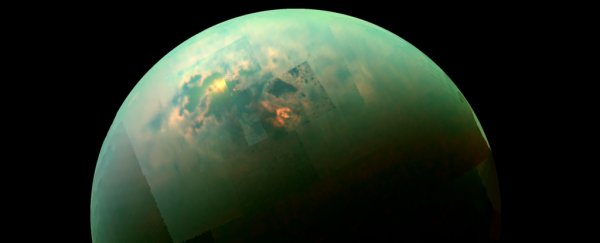Scientists have recreated Titan-like conditions in a lab, and found that organic molecules from Titan's atmosphere could be forming rings of alien crystals around the methane lakes that dot the Saturn moon's surface.
Previously, the team led by researchers at NASA's Jet Propulsion Laboratory had discovered two of these 'molecular minerals'. Now they've discovered a third, made of acetylene and butane, and believe it could be the most abundant one yet.
"We have demonstrated previously that some organic molecules readily form co-crystals in Titan-relevant conditions, including acetylene," they write in a conference abstract presented this week.
"We report here preliminary evidence for a third co-crystal between acetylene and butane, which could be the most common molecular mineral discovered so far."
Here on Earth, both acetylene and butane exist and are used as gases - the former for welding, the latter for lighters and camp stoves. Both compounds are believed to be very common on Titan, too, generated in the moon's hazy atmosphere.
But unlike Earth, when these compounds fall down to Titan's surface, where temperatures are pretty uniformly around 90 Kelvin, it's cold enough that they can actually form solid crystals.
In fact, when the research team made a mini "Titan soup" in a lab, they found that not only do the compounds go solid, but they even merge to form a co-crystal not found on Earth.
Using liquid nitrogen, the scientists cooled a specially designed chamber to Titan temperatures, and added a bunch of stuff in Titan proportions - methane and ethane, for instance, and acetylene and butane.
Then, they used a technique called Raman spectroscopy to examine the structure of the resulting crystals.
The first crystals to form were benzene, which formed a co-crystal with ethane. And acetylene and ammonia formed the second co-crystal. Now the butane-acetylene co-crystal has revealed itself, and it may be a lot more common than the other two.
"The co-crystal forms within minutes at 130 K, and is stable when cooled to Titan surface temperatures (90 K)," the team wrote. "A thermal stability study indicates that this co-crystal remains intact up to 180 K."
What's particularly cool is that these co-crystals don't just emerge randomly. Instead, we might be looking at structures of alien crystals encircling Titan's methane lakes.
This is because when the compounds fall from the sky, they are dissolved in the lakes. As these bodies of liquid evaporate - much like lakes do during Earth's water cycle - the compounds could form co-crystal evaporites around the edges, much like residue in a bathtub drained of dirty water.
Now, we don't know for sure that this is the landscape we would find if we visited Saturn's enigmatic moon, but there have been promising signs.
Near-infrared Cassini images of Titan do show what seem to be highly reflective, orange-coloured evaporite rings around some of the lakes in the moon's northern hemisphere.
"We don't know yet if we have these bathtub rings," said astrochemist Morgan Cable of NASA's Jet Propulsion Laboratory. "It's hard to see through Titan's hazy atmosphere."
There's more work the team can do here on Earth to try to get a clearer picture, though. The next part of the research will involve further study of the co-crystal itself, as well as searching for more such molecular minerals that may exist on Titan.
The team has presented these findings at the 2019 Astrobiology Science Conference.
